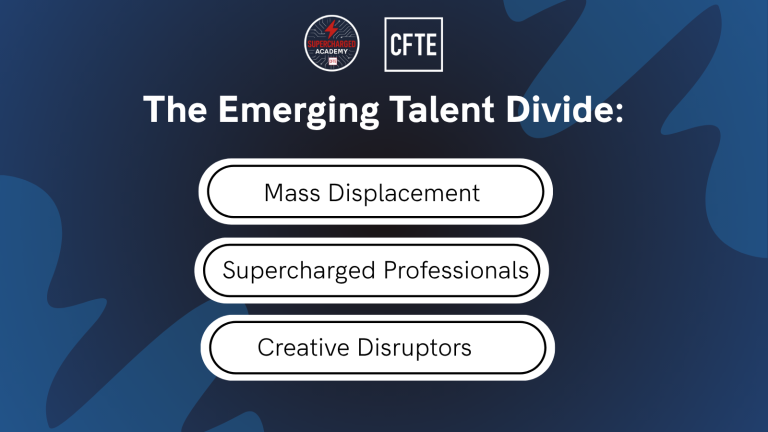AI is not just transforming tools — it’s fragmenting the very structure of the workforce.
While many worry about automation eliminating jobs, the bigger disruption is happening silently: the reclassification of talent itself.
According to CFTE’s whitepaper The AI-fication of Talents, the global workforce is diverging into three emerging profiles. And the implications are profound for employers, policymakers, and professionals alike.
1. Mass Displacement
These are individuals in roles centred on predictable, rule-based execution — where AI now performs faster, cheaper, and at scale.
Mass displacement isn’t always dramatic. It often begins with subtle signals: fewer projects, diminishing scope, delayed promotions. Eventually, relevance erodes.
And the danger? Most individuals and institutions don’t notice the decline — until it’s too late.
2. Supercharged Professionals
This group is redefining what one person can do.
By integrating AI into their workflows — not just for automation, but as a force multiplier — they’re operating at 10x or even 100x capacity.
They’re not just efficient. They’re strategic, bold, and structurally different.
These professionals aren’t tech specialists — they’re domain experts who’ve learned to harness AI to scale decisions, impact, and value.
3. Creative Disruptors
The smallest but most transformational group.
Disruptors aren’t using AI to improve old systems — they’re building new ones.
Startups creating AI-native business models. Policymakers redesigning regulatory frameworks. Educators inventing new forms of learning and assessment.
Disruptors don’t adapt. They reinvent.
Why This Divide Matters
The three profiles above aren’t hypothetical. They’re already visible inside most organisations — and across entire industries.
AI doesn’t impact all jobs equally. And more importantly, it doesn’t empower all individuals equally.
Without intentional intervention, Mass Displacement becomes the default path. Supercharging and disruption require strategy.
What Determines Your Path?
According to CFTE, it’s not age, seniority, or even technical skill that decides your trajectory.
It’s your ability to:
- Structure your work for leverage
- Think in systems, not tools
- Align with emerging value models
Two people with the same job title can end up in completely different categories — based on how they respond to this shift.
Institutional Implications
If you’re a leader, the divide isn’t just about individuals — it’s about the future structure of your workforce.
Ask yourself:
- Who are we investing in — Displaced or Disruptors?
- Are we building environments that supercharge talent?
- Do we have systems in place to recognise and support emerging profiles?
Ignoring the divide means letting your organisational potential quietly decline.
A Strategic Response
CFTE’s Performance Hexagon and CDE Innovation Prism offer new tools to map value, understand AI disruption, and define interventions.
Rather than reacting to roles, we must architect environments where talent adapts upward — not out.
The AI-fication of Talents breaks down these three profiles in detail — and provides strategies for individuals, institutions, and governments to shape more inclusive and future-ready outcomes.

